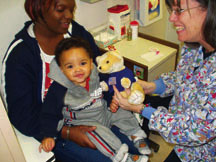Have You Seen America’s Hidden Third World?
Have You Seen America’s Hidden Third World?
When Americans imagine communities with dilapidated homes, barefoot children
and starving adults, they might picture Third World countries. But over 23
million U.S. residents live in deep rural poverty.
In 1964, President Lyndon Johnson launched his War on Poverty from Appalachia,
a 1,000-mile stretch that goes from southern New York to northeast
Mississippi. Although some communities have seen improvement since the 1960s,
the economic boom of the 1990s did little to improve living conditions.
Appalachian unemployment and earnings rates still fall below the national
average. Some areas still lack water and plumbing systems. While Appalachians
can often afford their own homes – coal companies built houses, then sold them
cheaply when they moved into new areas – few people can afford their
upkeep.
 Americans Helping Americans (AHA), a nonprofit organization that runs
several relief projects in
Appalachia, reports seeing homes without adequate roofs, walls and floors.
Americans Helping Americans (AHA), a nonprofit organization that runs
several relief projects in
Appalachia, reports seeing homes without adequate roofs, walls and floors.
People moved into Appalachia when the coal mining industry thrived, but most
coal mines have since moved West. Only 2 percent of Appalachia’s workforce
still mines, and they face job-related health risks. Most people work in
low-paid, unskilled sectors, where salaries cannot support living costs.
For children, rural poverty proves especially heartbreaking. Many Appalachian
children grow up without adequate food, shelter or healthcare – one in five
Appalachian children grow up in poverty. And few doctors work in Appalachia,
few residents have insurance or the means to pay medical fees. Simple toys
prove beyond many families’ means – paying for home repairs or dental visits
seems impossible.
For Appalachian children, simple donations, from teddy bears and blankets to
school supplies and Christmas dinners, help encourage confidence and personal
pride. AHA’s Bare Feet Program takes children to stores, where they can choose
and buy their own shoes, just like any other child.
AHA also helps supply food and blankets, utilities and home repairs to
struggling Appalachian families. Appalachians suffer a poorer standard of
living than most Americans, but relief work can help families emerge from the
nation’s hidden Third World. For more information, visit
www.helpingamericans.org.
Comments
Post a Comment